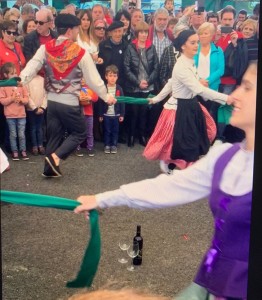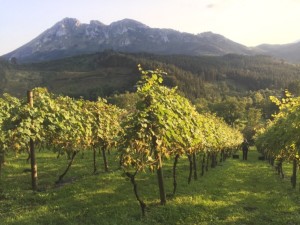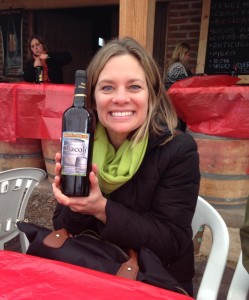
Celebrating Txakolina with dance in the town of Bakio
Today we have a guest post from Kerri Lesh, CSW and and Ph.d candidate. Kerri tells us about her search for Txakolina and other adventures in wine and the Basque Country of Spain. Kerri will be presenting a webinar on Txakolina and Basque wine on Saturday, March 9th at 10:00 am central time.
Now advertised as a “Culinary Nation,” the Basque Country of Spain (Hegoalde) has changed quite a bit over the last few decades. Known in the native language Euskara as Euskadi, this part of Basque Country has evolved from a nation associated with terrorism, to one of gastronomic fame. Touting more Michelin-star restaurants per capita than anywhere in the world, cities like San Sebastián/Donostia have become increasingly attractive to foreigners searching for sandy beaches as well as great food and wine. This city is located in the province of Gipuzkoa, which extends to what we know as the French border and the rest of the Basque Country (Iparralde). To the west of this city is Bilbao—located in the province of Biscay/Bizkaia—and joining the southern borders of these two provinces is Álava/Araba, with Vitoria-Gasteiz as its capital. These three provinces not only make up the Basque Autonomous Community, but each contains a Denominación de Origen (DO) for Txakolina: Getariako Txakolina, Bizkaiko Txakolina, and Arabako Txakolina.

My first walk among the vineyards around Getaria
Just as the Basque Country is transforming, so is Txakolina. This wine—known as either Txakoli or Txakolina—has changed considerably over the last few hundred years. Its debated etymological roots, stemming from “etxeko ain,” meaning “enough for the home,” link this wine to the Basque language and local production for the home. As I interviewed people while living in the Basque Country, I found this iconic wine had not always had such a positive reputation. Older generations had a much different perspective on it than the younger generations of Basques and the tourists who have only had access to Txakoli for the last decade or so.
Production methods have changed the taste of Txakoli both abroad and closer to home. Today, there are three different styles of the wine—white, rosé, and red. However, well before designations of origin protected Txakolina, an advertisement for “Chacoli de Ezcaba” (the Castilian spelling) indicates that a wine with the same name was once produced in the province of Navarra with Garnacha. This would have been much different from the Txakolina produced today in the three DOs.

A vineyard of Hondarribi Zuri near where I lived outside of Elorrio withi Udalaitz Mountain in the background
Cultural tastes play a role in the Txakolina available to consumers. While a rosé version of the wine made by producers such as Ameztoi and Txomin Etxaniz can commonly be found in the United States, drinking the rosé version is not part of local Basque culture. Most producers depend largely on the white grape Hondaribbi Zuri to make white wine, exporting rosé, which typically incorporates the red grape Hondaribbi Beltza, to countries such as the United States. Over time, producers such as Doniene Gorrondona have even created a version of Txakolina using the Traditional Method as well as red.
In addition to helping with a 2017 harvest in the Basque Country, I also had the opportunity to work a harvest in Casablanca, Chile. One weekend after the harvest was complete, a few colleagues from the winery and I got in a car in search of the Chilean Chacoli. I had read that Chacoli could be found near the Chilean city of Doñihue.

Discovering Chacoli in Chile
It took some digging around to find this wine, which included asking locals traveling on horseback and knocking on doors. After hours of driving around, we found one bodega and a couple of people who claimed to make it, mostly for local consumption. It tasted nothing like the Txakolina made in the Basque Country, which made sense considering the use of different grape varietals and production methods. Most of the producers also referred to their chacoli as chicha, a beverage typically from Latin America that is fermented from fruits or grains. While living in the Basque Country in 2017, I received news that a group of Chilean producers were revitalizing the production of Chacoli as a local artisanal wine that would typically be sold at local festivals and celebrations. Unlike its Basque ancestor, this version does not have a geographical or designation of origin.
It will be interesting to see how this wine will continue to change across the Basque DOs. and in Chilean artisanal production. Today in the Basque Country, the scale of Txakolina has evolved from being just “enough for the home,” to now being sold across the globe. It is also no longer solely advertised as a young white wine to be drunk soon after it is bottled, and can be enjoyed in its many forms over time whether it is white, rosé, or red; slightly effervescent, still, or sparkling; young or aged. As tourism continues to increase in the Basque Country, in turn opening up these winegrowing regions to globalized tastes, what will Txakolina look like in another 20 years?
Kerri Lesh, CSW and Ph.d candidate, will present a webinar on Txakolina and the Basque Country on Saturday, March 6th at 10:00 am central time. Click here f or more information on the March 9th webinar.
For more posts and interviews from Kerri Lesh, please visit http://www.kerrilesh.com/
Photo credits: Kerri Lesh, Cameron Watson
This was a great article, did not know it came in red and rosé styles.